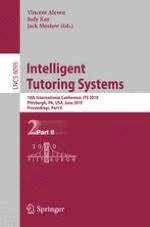The 10th International Conference on Intelligent Tutoring Systems, ITS 2010, cont- ued the bi-annual series of top-flight international conferences on the use of advanced educational technologies that are adaptive to users or groups of users. These highly interdisciplinary conferences bring together researchers in the learning sciences, computer science, cognitive or educational psychology, cognitive science, artificial intelligence, machine learning, and linguistics. The theme of the ITS 2010 conference was Bridges to Learning, a theme that connects the scientific content of the conf- ence and the geography of Pittsburgh, the host city. The conference addressed the use of advanced technologies as bridges for learners and facilitators of robust learning outcomes. We received a total of 186 submissions from 26 countries on 5 continents: Aust- lia, Brazil, Canada, China, Estonia, France, Georgia, Germany, Greece, India, Italy, Japan, Korea, Mexico, The Netherlands, New Zealand, Pakistan, Philippines, Saudi Arabia, Singapore, Slovakia, Spain, Thailand, Turkey, the UK and USA. We accepted 61 full papers (38%) and 58 short papers. The diversity of the field is reflected in the range of topics represented by the papers submitted, selected by the authors.
